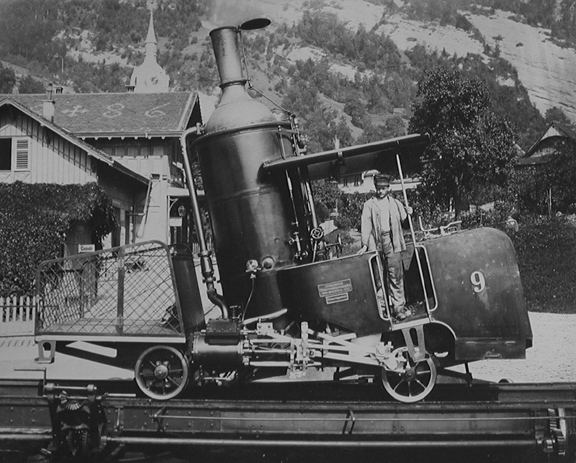On the 21st of May, 1871, a significant milestone in European rail history was achieved with the inauguration of the Rigi Bahnen on Mount Rigi, Switzerland. This event marked the opening of the first rack railway in Europe, a pioneering feat that not only revolutionised mountain travel but also set the stage for the development of alpine tourism.
The Visionary Behind the Project
The Rigi Bahnen was the brainchild of Swiss engineer Niklaus Riggenbach. Riggenbach, who had previously patented a rack and pinion system in France in 1863, envisioned a railway that could conquer the steep inclines of Mount Rigi. His innovative system involved toothed racks set between the railway tracks, which interlocked with cogwheels fitted under the locomotives. This design allowed trains to safely and efficiently navigate gradients that would be impossible for conventional railways.
Construction and Technical Details
 Construction of the Vitznau-Rigi Bahn began in September 1869, following the approval from the canton of Lucerne. The project was ambitious, involving the laying of tracks from Vitznau, on the shores of Lake Lucerne, to Rigi Staffelhöhe, a point just below the summit of Mount Rigi. The line covered a distance of 5 kilometres (3.1 miles) and climbed a total of 1,115 metres (3,658 feet), reaching an altitude of 1,550 metres (5,085 feet) at its highest point. The maximum gradient of the railway was an impressive 1 in 4 (25%).
Construction of the Vitznau-Rigi Bahn began in September 1869, following the approval from the canton of Lucerne. The project was ambitious, involving the laying of tracks from Vitznau, on the shores of Lake Lucerne, to Rigi Staffelhöhe, a point just below the summit of Mount Rigi. The line covered a distance of 5 kilometres (3.1 miles) and climbed a total of 1,115 metres (3,658 feet), reaching an altitude of 1,550 metres (5,085 feet) at its highest point. The maximum gradient of the railway was an impressive 1 in 4 (25%).
The construction process was a marvel of engineering and logistics. Workers had to contend with the challenging mountainous terrain, often working in harsh weather conditions. Despite these obstacles, the railway was completed in just under two years. On the 21st of May, 1870, Riggenbach himself drove the first locomotive, named Stadt Luzern, on a trial run to Rigi Staffelhöhe. Exactly one year later, the railway was officially opened to the public.
The Inauguration Ceremony
The inauguration of the Rigi Bahnen was a grand affair, attended by numerous dignitaries, business leaders, and journalists. The Neue Zürcher Zeitung, a prominent Swiss newspaper, reported on the event, highlighting the excitement and anticipation that surrounded the opening. One journalist described the experience of boarding the first train under the personal direction of Director Riggenbach, noting the sense of security and marvel that quickly dispelled any fears about the new technology.
Another contemporary account from the Journal de Genève reassured readers about the safety of the railway, emphasising that the Rigi line seemed safer than any lowland line. The correspondent observed the meticulous care taken by the railway staff, who worked in shifts to ensure the smooth and safe operation of the trains.
Impact on Alpine Tourism
 The opening of the Rigi Bahnen had a profound impact on tourism in the region. The hour-long journey from Vitznau to Rigi Staffelhöhe offered breathtaking views of the Swiss Alps and Lake Lucerne, attracting tourists from across Europe. The success of the Rigi Bahnen inspired the construction of other cogwheel railways in the Alps, including the Jungfrau Railway, which was built between 1898 and 1912 and reached an altitude of 3,454 metres (11,332 feet).
The opening of the Rigi Bahnen had a profound impact on tourism in the region. The hour-long journey from Vitznau to Rigi Staffelhöhe offered breathtaking views of the Swiss Alps and Lake Lucerne, attracting tourists from across Europe. The success of the Rigi Bahnen inspired the construction of other cogwheel railways in the Alps, including the Jungfrau Railway, which was built between 1898 and 1912 and reached an altitude of 3,454 metres (11,332 feet).
The Rigi Bahnen also played a crucial role in promoting the concept of mountain tourism. The railway made it possible for people of all ages and physical abilities to experience the beauty of the Swiss Alps, paving the way for the development of hotels, resorts, and other tourist amenities in the region.
Technical Innovations and Legacy
The Rigi Bahnen was not only a marvel of engineering but also a testament to the innovative spirit of its creators. The rack and pinion system developed by Riggenbach proved to be highly effective, allowing trains to safely navigate steep gradients and sharp curves. This technology was later adopted by other mountain railways around the world, cementing Riggenbach's legacy as a pioneer in railway engineering.
Today, the Rigi Bahnen continues to operate, offering both historical and modern train services to visitors. The original steam locomotives, including the iconic Lok 7 built in 1873, are still in use for special occasions, providing a nostalgic glimpse into the past.
The opening of the Rigi Bahnen was a landmark event that transformed mountain travel and tourism in Europe. It showcased the ingenuity and determination of its creators, who overcame significant technical and logistical challenges to bring their vision to life. The railway remains a symbol of Swiss engineering excellence and a beloved attraction for tourists from around the world.
Share Your Thoughts
How did the success of the Rigi Bahnen influence the development of other mountain railways? What lessons can we learn from the innovative spirit of Niklaus Riggenbach and his team? Have you ever travelled on a rack railway? Share your thoughts in the comments below!
#OnThisDay